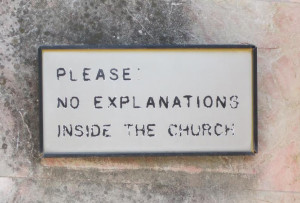 Some years ago I had the opportunity to visit the Holy Land with a large tour group. We spent two weeks traveling around Israel and Palestine but spent most of our time in and around Jerusalem.
Some years ago I had the opportunity to visit the Holy Land with a large tour group. We spent two weeks traveling around Israel and Palestine but spent most of our time in and around Jerusalem.
One of the most powerful sites we visited was a small garden of olive trees at the foot of the Mount of Olives which tradition has cited as Gethsemane. As with so many of these traditional holy sites, there’s also a church next to the garden that still functions, known as the Church of All Nations, with a small terrace where tour groups and other visitors wait their turn to go in.
Our group was gathering on the terrace as we waited to enter when I happened to notice an old metal sign on one of the stone pillars at the front of the church facing this terrace. I had to look closely because it was so worn and faded by the elements, but when I got close enough I saw that the sign read the following:
“Please: No Explanations Inside the Church.”
Now in Israeli tour-group-speech, “explanations” are the commentaries or comments provided by tour guides as they lead their groups around the different sites. All over the Holy Land you’ll see these groups of tourists huddled around their guides, listening attentively to their “explanations.” The good folks from the Church of All Nations were clearly hoping to keep the noise of these tour groups out of their place of worship.
 But it struck me then, and still does today, that their request, “Please: No Explanations Inside the Church,” applies to more than just tour groups standing outside a church. It’s good advice for those of us in the church as well, especially when it comes to the story of Gethsemane and beyond. When it comes to resurrection, explanations can only take us so far.
But it struck me then, and still does today, that their request, “Please: No Explanations Inside the Church,” applies to more than just tour groups standing outside a church. It’s good advice for those of us in the church as well, especially when it comes to the story of Gethsemane and beyond. When it comes to resurrection, explanations can only take us so far.
Not that this has stopped plenty from trying.
If you grew up in church, chances are you’ve heard your share of Easter sermons with the stated purpose of proving exactly what happened in the tomb that first Easter morning.
I remember one sermon in particular I heard as a child at my grandmother’s church where the preacher took on the persona of a lawyer making “the case” for the “truth” of the resurrection as in a court of law:
We have the eyewitness testimony of women at the tomb, the disciples after that, and then more than 500 brothers and sisters — friends, the empty tomb is an open and shut case!
Say what you want about the approach, but you can’t argue with the rhetorical flourish.
Of course, much of this simply comes down to how you understand the historical nature of the Gospels. If you choose to read them the same way you would a history textbook (although, with all the controversy around those these days, that might not be the best example; then again, it may be the perfect one), then these sorts of arguments make complete sense.
But if you choose to take a different view, and think it’s both unwise and unfair to judge the Gospels, and the rest of Scripture for that matter, by the standards of modern history or biography, then these arguments become about as empty as … well, the tomb.
In any case, the real weakness with these “explanations” of the resurrection has less to do with historical accuracy and more to do with theology. Simply put, they attempt to do something that not even the Gospels themselves are willing to do.
It should tell us something that when recording the events of that first Easter morning, that crucial moment of the Christian faith, the Gospel writers don’t attempt to explain what exactly happened in the tomb. There’s no frame by frame of the time in-between the moment of truth, so to speak, and when the stone was rolled away. No monologue from Jesus about how he felt when he got up, or where he was in the days in between.
Instead, we’re given testimonies of those standing outside the tomb, what the people around Jesus experienced that first day of the week. What they saw and didn’t see. Who met them later along the way.
Put another way, the Gospel writers were more interested in describing resurrection encounters than resurrection explanations. Asking not, How was Christ raised? but How did you meet him? Or maybe, How did he meet you? Who led you to him? And finally, How did you respond?
When it comes to Easter sermons, not only is this approach more faithful to the gospel witness, it’s also more effective, if you like.
I don’t know a single person who’s ever come to faith in God through Jesus Christ by means of explanation. However, I know a great many who have come to such faith by means of encounter. Encounters with the risen Christ, often through their relationships with others, very often experienced within the context of that much maligned institution whose eulogies can be read far and wide: the church.
So please, this Easter season, read the sign: No Explanations Inside the Church.
And if you like, add one more line: Encounters Will Be Enough.
